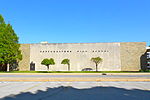York Haven, Pennsylvania
1892 establishments in PennsylvaniaBoroughs in York County, PennsylvaniaPages with non-numeric formatnum argumentsPennsylvania populated places on the Susquehanna RiverPopulated places established in 1814

York Haven is a borough in York County, Pennsylvania, United States. The population was 691 at the 2020 census. The borough is the home of the Brunner Island coal-fired electrical generation plant, located on the Susquehanna River on Wago Road and operated by PPL Corporation.
Excerpt from the Wikipedia article York Haven, Pennsylvania (License: CC BY-SA 3.0, Authors, Images).York Haven, Pennsylvania
2nd Street,
Geographical coordinates (GPS) Address Nearby Places Show on map
Geographical coordinates (GPS)
| Latitude | Longitude |
|---|---|
| N 40.109444444444 ° | E -76.714722222222 ° |
Address
2nd Street 30
17370
Pennsylvania, United States
Open on Google Maps








